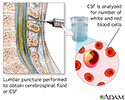Pneumococcal meningitis
Pneumococcus - meningitis
Meningitis is an infection of the membranes covering the brain and spinal cord. This covering is called the meninges.
Bacteria are one type of germ that can cause meningitis. The pneumococcal bacteria are one kind of bacteria that causes meningitis.
Causes
Pneumococcal meningitis is caused by Streptococcus pneumoniae bacteria (also called pneumococcus, or S pneumoniae). This type of bacteria is the most common cause of bacterial meningitis in adults. It is the second most common cause of meningitis in children older than age 2.
Risk factors include:
- Alcohol use
- Diabetes
- History of meningitis
- Infection of a heart valve with S pneumoniae
- Injury or trauma to the head
- Meningitis in which there is leakage of spinal fluid
- Recent ear infection with S pneumoniae
- Recent pneumonia with S pneumoniae
- Recent upper respiratory infection
- Spleen removal or a spleen that does not function
Symptoms
Symptoms usually come on quickly, and may include:
- Fever and chills
- Mental status changes
- Nausea and vomiting
- Sensitivity to light (photophobia)
- Severe headache
- Stiff neck
Other symptoms that can occur with this disease:
- Agitation
- Bulging fontanelles in infants
- Decreased consciousness
- Poor feeding or irritability in children
- Rapid breathing
- Unusual posture, with the head and neck arched backwards (opisthotonos)
Pneumococcal meningitis is an important cause of fever in infants.
Exams and Tests
Your health care provider will perform a physical exam. Questions will focus on symptoms and possible exposure to someone who might have the same symptoms, such as a stiff neck and fever.
If your provider thinks meningitis is possible, a lumbar puncture (spinal tap) will likely be done. This is to obtain a sample of spinal fluid for testing.
Other tests that may be done include:
- Blood culture
- Chest x-ray
- CT scan of the head
- Complete blood count (CBC)
- Gram stain or other special stains, and culture of the spinal fluid
Treatment
Antibiotics will be started as soon as possible. Ceftriaxone is one of the most commonly used antibiotics.
If the antibiotic is not working and your provider suspects antibiotic resistance, vancomycin or rifampin may be used. Sometimes, corticosteroids are also used.
Outlook (Prognosis)
Meningitis is a dangerous infection and it can be deadly. The sooner it is treated, the better your chance for recovery. Young children and adults over age 50 have the highest risk for death.
Possible Complications
Long-term complications may include:
- Brain damage
- Buildup of fluid between the skull and brain (subdural effusion)
- Buildup of fluid inside the skull that leads to brain swelling (hydrocephalus)
- Hearing loss
- Seizures
When to Contact a Medical Professional
Call 911 or the local emergency number or go to an emergency room if you suspect meningitis in a young child who has the following symptoms:
- Feeding problems
- High-pitched cry
- Irritability
- Persistent unexplained fever
Meningitis can quickly become a life-threatening illness.
Prevention
Early treatment of pneumonia and ear infections caused by pneumococcus may decrease the risk of meningitis. There are also two effective vaccines available to prevent pneumococcus infection:
The following people should be vaccinated, according to current recommendations:
- Children
- Adults age 65 and older
- People at high risk for pneumococcus infection
References
Centers for Disease Control and Prevention website. Meningitis. About bacterial meningitis. www.cdc.gov/meningitis/about/bacterial-meningitis.html. Updated January 9, 2024. Accessed September 3, 2024.
Hasbun R, Van de Beek D, Brouwer MC, Tunkel AR. Acute meningitis. In: Bennett JE, Dolin R, Blaser MJ, eds. Mandell, Douglas, and Bennett's Principles and Practice of Infectious Diseases. 9th ed. Philadelphia, PA: Elsevier; 2020:chap 87.
Nath A. Meningitis: bacterial, viral, and other. In: Goldman L, Cooney KA, eds. Goldman-Cecil Medicine. 27th ed. Philadelphia, PA: Elsevier; 2024:chap 381.
Ramirez KA, Peters TR. Streptococcus pneumoniae (pneumococcus). In: Kliegman RM, St. Geme JW, Blum NJ, et al, eds. Nelson Textbook of Pediatrics. 22nd ed. Philadelphia, PA: Elsevier; 2025:chap 228.
Review Date: 8/29/2024





















